GBDOU 57 St. Petersburg
Continuing the theme of sensory parenting early age, I would like to point out the variety of didactic games. In preschool practice, all d / and can be divided into 3 main types:
Games with objects;
Board and printed games;
Word games.
I would like to offer a number of games that we have made with our own hands:
1. Find a couple
Target:to carry out the choice of color according to the sample, to consolidate knowledge of the names of the primary colors, to develop attention.
Material:4 pairs of mittens in different colors (red, yellow, blue, green).
Game progress:V-l gives the child a mitten, the rest are laid out on the table. "Find the same color." The child finds the second mitten and says what color they are. 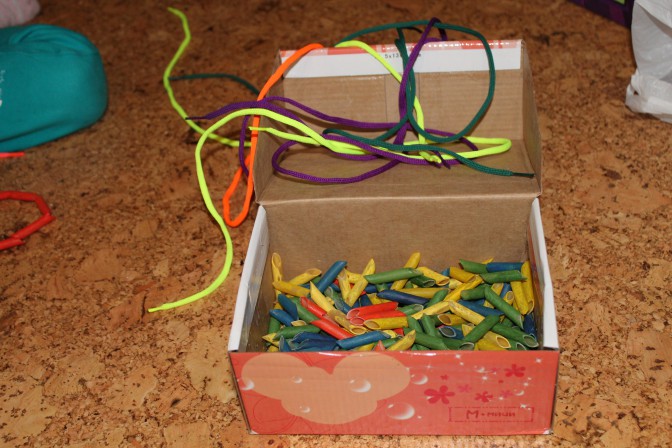
2. fold the ball
Target:learn to fold a circle of two and four parts, learn to select parts by color, learn the names of primary colors.
Material: circles of four colors, cut into 2 and 4 parts.
Game progress:V-l distributes the halves of the “ball” to the children, the children look for the other half and fold the “ball”. V-l gives the task to the child: "Fold the ball red and blue." 
3. Decorate the Christmas tree
Target:to consolidate the ability to distinguish objects by size, to learn to distinguish objects by color, to make a choice according to a model, to learn the names of primary colors.
Material:on the sheet there is a green Christmas tree, a set of geometric shapes of 2 sizes and 4 colors.
Game progress:V-l says: "Look, what a beautiful green Christmas tree, let's decorate it." Vl takes a certain figure and hangs it on a Christmas tree and invites the children to find the same one. Then the children decorate the Christmas tree as they wish, naming the color and shape of the object. 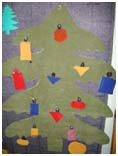
4. Find a butterfly flower
Target: learn to distinguish colors, introduce the names of colors (red, blue, yellow).
Material:flowers of red, blue and yellow flowers and butterflies of the same color.
Game progress:flowers are laid out on the carpet, butterflies are distributed to children. Children run in different directions(butterflies fly). Suddenly a bird flies, butterflies hide (sit on a flower of the same color). V-l explains: “The yellow butterfly sat on yellow flower etc. Butterflies hid, they are not visible. 
5. Sticks (balls) in places
Target:learn to distinguish, correlate and group objects by color.
Material:cups of 4 primary colors and a set of sticks (balls) of the corresponding color.
Game progress:Vl invites the children to arrange the sticks (balls) in cups of the corresponding colors. 
6. Mailbox
Target:to learn to see the form in the object, to correlate the shape of the slot and the object, choosing the right ones with the help of samples and applications.
Material: box with slots of various shapes, three-dimensional geometric figures corresponding to the slots of the box.
Game progress:The child is invited to drop all the "parcels" in the mailbox, i.e. determine which slot fits one or another shape. In case of difficulty, he asks the child to try on the figure to the slot, turning it to the right side. 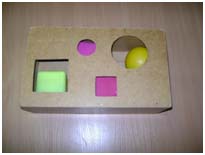
Ekaterina Almazova
When I started working as an educator, a lot appeared in my head different ideas . Namely, how diversify children's games, to make it so that it develops and amuses)
All games that I make are tested for quality and strength by my children, and then, if they approve, they fall into group to my pupils. Also my children help me in making them.
So, I want to bring to your attention a few games literally from nothing) always in the house.
"Funny pasta"
Ordinary pasta was painted with gouache of primary colors. The game helps to develop fine motor skills - you can make beautiful and bright beads, bracelets from pasta, stringing them on strings.

Except Togo we work out the names of the primary colors again, learn to name them correctly, choose (work in nursery group ) . Macaroni can be laid out on different bowls given their color.
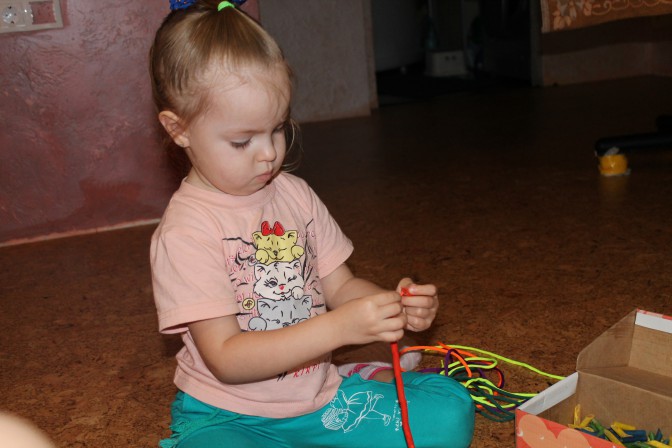
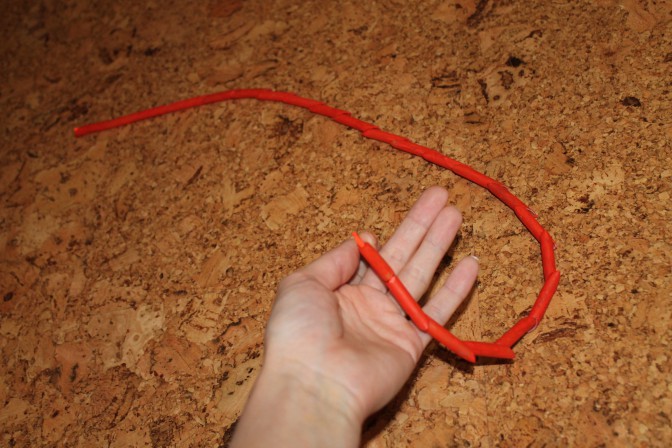
Here is what my daughter got - red beads for mom)
"Loose chest"
I call this game "Loose Chest". Although this is not a chest at all) an ordinary box from children's shoes, in it different cereals, pasta. You can play on differently: hide and find small toys, "boil soup" from different ingredients, or from any one, sprinkle with fingers or use a spoon (shovel, rake) V different bowls. This is how easy it is to captivate children with the most simple things) Yes, it's better to play on tape to make it easier to remove.
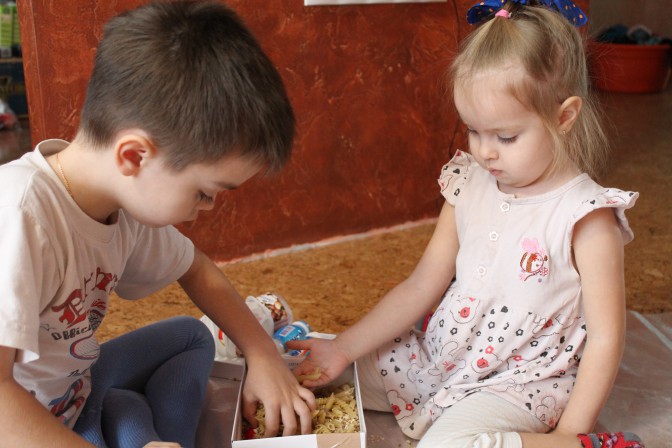
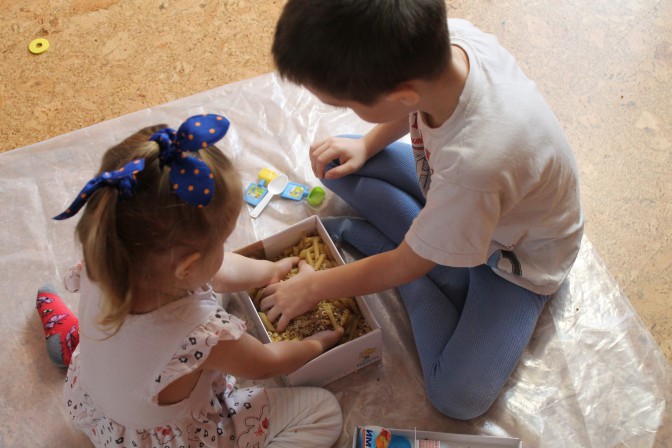
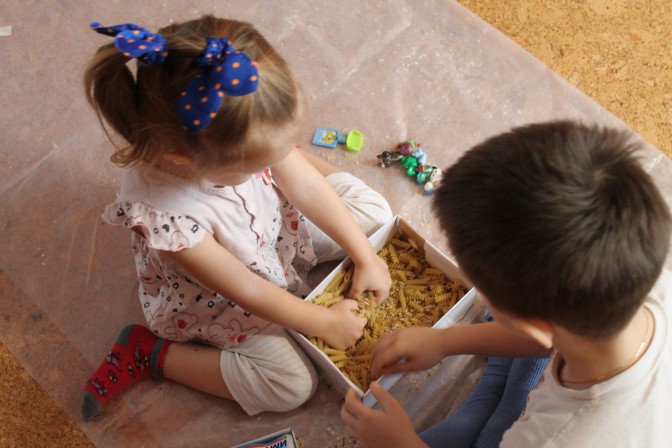
This game also perfectly develops fine motor skills, stimulates tactile sensations well, and causes positive emotions.
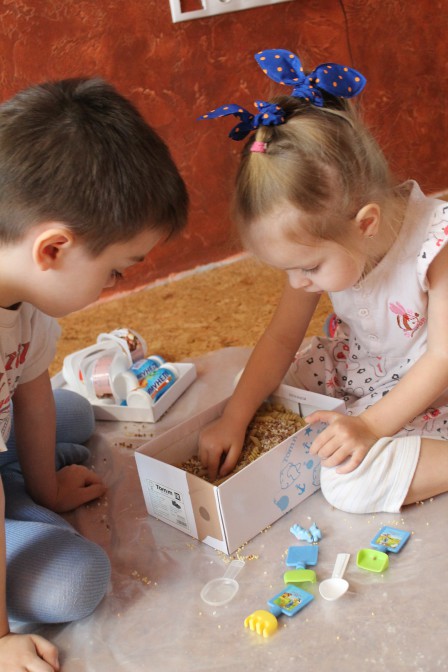

"Music Cubes"
To create this games I used junk material - empty boxes, mostly from medicines. I wanted to create a kind of constructor for children.
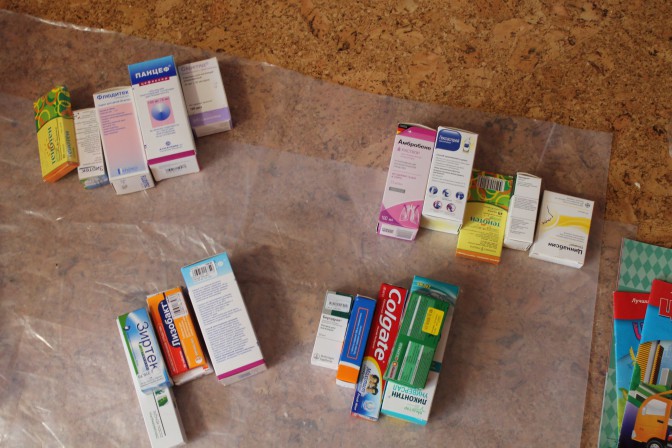
But these are not just cubes for building houses and towers, but a little more)
I wanted them to sound more. And the kids and I found something to fill our boxes with.
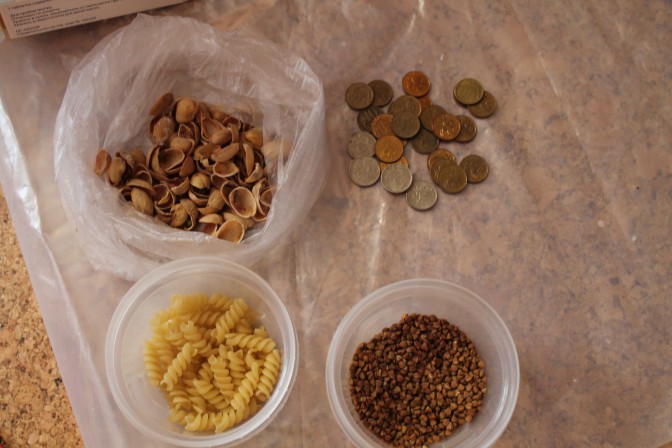
After this all boxes were pasted over with colored paper of primary colors. But so that all boxes of the same color sound the same. Such cubes not only develop imagination in terms of design, but also help to learn colors, develop auditory perception. And they are very comfortable in the game - small and light.
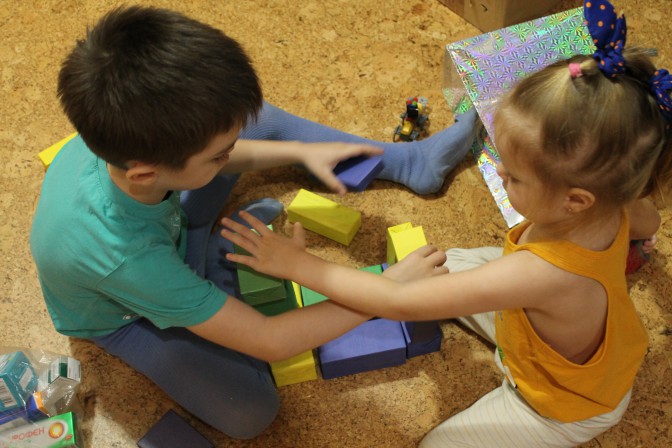
Here's what we did with the kids.
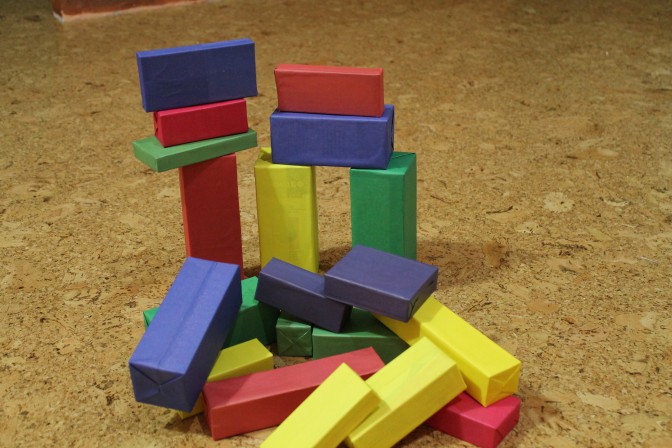

And this Total only a small part Togo, from which you can make interesting and informative games. There are many new discoveries ahead!
Related publications:
Each teacher strives to make classes entertaining and interesting. And for children to be attentive during GCD, not to be distracted, right.
I bring to your attention a small set of simple didactic games for educating sensory skills, which are very helpful in ours.
Didactic games in the first junior group D / and "Funny Figures" Purpose: to learn to distinguish between geometric shapes (circle, square, triangle, classify shapes by color and shape.
Didactic game (sensory development).
1. "Vegetable shop".
didactic task. Expand ideas about shape, size, color; develop the skills of comparing objects.
game task. Be good sellers, choose the right vegetables for buyers.
Game rule. Do not make mistakes when sorting goods, do not anger the director of the hedgehog.
Game progress.
The teacher invites the children to a new vegetable store. There are a lot of goods on the counter: beets, potatoes, carrots, tomatoes. Invites children to work in the store as sellers. The manager of the hedgehog store invites the sellers and gives them a task: arrange them in baskets so that buyers can quickly buy it: select round-shaped vegetables in the baskets. If the children are wrong, the hedgehog snorts angrily.
Game variant. You can offer children to deliver vegetables from the vegetable base by car to kindergartens, shops (select only red vegetables; pack vegetables of larger and smaller sizes).
2. "We are building a house."
game task. Build dog and cat houses.
Game rule. Choose a building material that your dog and cat will like.
Game progress.
The teacher brings a dog and a cat (toys) to the group, reports that these animals want to build houses, and offers help in construction: “The dog wants a house made of bricks, the cat wants to make cubes. Gotta go to the store building materials. The store has a lot of goods.
Children choose the right material among bricks, cubes and balls; they load the goods into the car and drive them, then they build houses: from bricks - for the dog, from cubes - for the cat.
Children build their own houses. Show the dog and cat their houses. Animals rejoice and dance merrily.
Game variant. You can invite children to build houses from cubes of different colors: a dog - from red, a cat - from blue.
3. "Different mugs for a hare and a fox."
didactic task. Develop children's ideas about shape, size, color.
game task. Select rugs for the hare and fox.
Game rule. Correctly select the mats and load them onto cars of the appropriate colors.
Game progress.
The teacher brings two houses and tells the children that one house is for a fox, the other is for a hare. The animals are doing repairs in the houses, bought furniture, and decided to lay new rugs on the floor. Invites children to help the animals choose rugs - the fox and the hare love rugs that look like mugs. The teacher shows the rugs: green and red (plates from the construction kit or pieces of colored paper). Children should take away the rugs and load them onto the car, for the fox - red circles, for the hare - green.
Game variant. Invite the children to select rugs large and small of the same color; different colors, different forms one color.
4. "Big and small balls."
didactic task. Learn to distinguish between color and size (large - small); develop a sense of rhythm; pronounce words rhythmically.
game task. Pick up balls for dolls.
Game rule. Choose the right balls by color and size.
Game progress.
The teacher gives to consider the balls of different colors (blue, green, red, yellow) and different sizes (large and small). Shows how they bounce rhythmically, and says:
Jump yes jump
Everybody jump and jump
Sleep our ball
Not used to.
The teacher takes out two dolls - large and small - and says: “ big doll Olya is looking for a ball for herself. The little doll Ira also wants to play with the ball.” Invites children to pick up balls for dolls. Children select the balls of the desired size (a large doll - a big ball, a small doll - a small ball). Doll Olya is naughty: she needs a yellow ball, like her skirt. Doll Ira is also angry: she needs a red ball, like her bow. The teacher invites the children to calm the dolls: pick up the right balls for them.
Didactic games(fine motor skills).
- "Colorful balls"
Purpose: development fine motor skills hands, fixing the primary colors.
Equipment: white and silver cardboard, basic color markers, glue stick, colored cardboard balls, laminating tape, pictures fairytale heroes, Velcro.
Game progress: the teacher asks the children to attach the balls in colors.
- "Funny Pencils"
Goal: improving hand coordination, developing finger mobility, fine motor skills.
Equipment: multi-colored pencils, kinders, eyes.
Course of the exercise: The child rolls a pencil between his palms, fingers, saying: “I roll the pencil in my hands, I twist it between my fingers.
I will certainly teach each finger to be obedient.
- "Pears and Apples with a Button"
Purpose: to exercise children in reinforcing the concepts of “big - small pear”, to teach how to fasten and unfasten pears, apples, where the child reinforces the concepts of “one”, “many”, the development of fine motor skills of hands.
Equipment: pictures of apples, pears, threads, buttons, cardboard for tree layout, adhesive tape for “lamination”.
Game progress: Let's play "Hurricane" - blowing on a tree and swinging it with one hand, the teacher or child unfastens an apple from it. "Bang! The wind blew the apple away and it fell to the ground. They offer the child to be the wind - to blow, shake the tree, then unfasten the apples.
- "Feed the bun"
Purpose: development of fine motor skills and tactile sensitivity.
Equipment: low plastic jars with lids, cereals (beans, peas, buckwheat and others).
Game progress: the teacher tells the children that our Kolobok is hungry and needs to be fed. Children take cereal from a jar and put it in the mouth opening.
- "Grains-notions!"
Purpose: strengthening and development of fine motor skills of the hands, hand-eye coordination; the formation of the ability to combine by color (when using various cereals).
Equipment: different kinds cereals (beans, rice, millet and others).
Game progress: First, it is necessary to pour millet into an even layer on a tray (other cereals are also possible), and then, using red beans (this way the contrasting color stands out better), they come up with and impose different patterns, pictures.
- "Paint a picture with corks"
Purpose: to develop the imagination, creativity of children, fine motor skills of hands.
Equipment: illustrations depicting flowers, an airplane, a Christmas tree, a fly agaric, a cork or a button.
Game progress: the teacher asks to finish the picture using corks or buttons.
- "Colorful clothespins"
Purpose: to develop fine motor skills, imagination. Expand knowledge about the world around us, Exercise children in the ability to count and count, consolidate knowledge about color. Learn to take and open clothespins correctly, find the location by color. Cultivate an emotional attitude to the results of their work, perseverance, patience.
Equipment: planar image of objects (sun, plane, caterpillar, fish, turnip, beetroot, pineapple, house, hedgehog and others), clothespins.
Game progress: The teacher draws the attention of the children that the artist painted objects, but forgot to draw some details. Invite the children to help the artist and use clothespins to finish the picture.
Didactic games (musical).
- "SUN"
Tasks: To consolidate the skills of performing simultaneously “springs” and claps, jumps and claps.
Game progress:
\ Sun, \ sun,
/ Look in \window:
\ Your children \ cry,
/ They jump over pebbles.
Game progress
On the 1st and 2nd lines of the test, an adult, together with the children, performs frequent half-squats - “springs” - and at the same time claps his hands.
Under the text of the 3rd and 4th lines, jumps are performed with simultaneous clapping.
The text is pronounced at a slow pace, in a singsong voice, with a pronounced metrical pulsation, without stops, accelerations and decelerations.
\ Sun, \ sun, / Look out the \ window, etc.
- "POSKOK"
Tasks: to develop the expressiveness of performing light jumps, a soft spring step.
Jump, jump - jump moving forward
Young Thrush jumping
I went along the water, they go soft spring
Found a young lady. step
Young lady, narrow the circle
small,
/ Itself with inches, sit down
Head with a pot. put palms on cheeks
They shake their heads.
Game progress
Children stand in a circle, bending their arms at the elbows, fists pressed to their shoulders - imitate wings. In the center of the circle is a bird (toy)
- "CLAPS - SPLANTS"
Tasks: development of a sense of rhythm, coordination of movements in accordance with the tempo of the music.
Game progress: starting position - legs wide apart, children sit on the floor.
/ Clap \ times, clap on the word "clap"
/ Another \ time blow of the palms on the knees
On the word "once"
/ We FSUs \ burst \ now repeat movements
And then quickly, quickly, the rhythmic strokes of the palms of
Slap, spank more fun. floor
The first three lines are pronounced with a pronounced rhythmic pulsation, the descending intonation of the voice falls on each strong beat.
The last two lines are sentenced at an accelerated pace
- "CLAP YOUR HANDS"
Tasks: Development of a sense of rhythm, coordination, the ability to coordinate movements with the text.
Game progress:
Shadow-\shadow, sweat\shadow. Rhythmic clapping
Sela \ cat under the plait \ shadow. knees
Sparrows flew in, Waving their hands
"wings"
\ Clap their hands. clapping
Fly away sparrows! They threaten with a finger
Beware of the cat!
- "PUSSY, SHUT
Tasks: To improve the skill of walking on the spot,
the ability to end the movement with the end of the text.
Game progress:
Pussy, pussy, pussy, come on! children wag their fingers
Don't sit on the path
Our baby will go, they are walking in place
Through the pussy will fall!
Bach! squat
Guidelines. When walking, you should pay attention to the posture of children, to improve which you need to put your hands on your belt. The end of the pronunciation of the text should be clearly fixed - the children squat.
- "TRA-TA-TA"
RUSS. PEOPLE'S JOY
Tasks: Development of large motor skills, coordination of movements.
Tra-ta-ta! Tra-ta-ta! Children clap their hands
A cat married a cat!
For the cat Kotovich, they give two slaps on the knees
Hands at the same time
For the cat Petrovich! Do two knee slaps
Two hands alternately
- "Cucumber"
Objectives: To consolidate the skills of performing light jumps with forward movement, a soft springy step and an easy fast run.
Cucumber, cucumber,
Don't go to that end
The mouse lives there
Your tail will bite off.
A "trap" is chosen for the game. It can be one of the adults or a child. "Trap" goes to the other end of the hall. The hands of the players are on the belt.
Game progress
“The trap sits on a chair against one of the walls of the room, the children gather in a flock against the other wall. On the text of the 1st and 2nd lines, the children move in the direction of the "trap". Under the text of the 3rd line, the children continue to move with a soft springy step, shaking their finger at the “trap”. Last phrase be pronounced by children. Standing still, and is a signal to run. The "trap" catches up with the children running away from him.
The text is pronounced expressively, in a singsong voice, at the end of the 3rd line there should be a slight pause, while the voice “climbs up”: there is a mouse
live / wet. The last line is pronounced tongue twister.
- "LOCOMOTIVE"
Tasks: to consolidate the skill of a fractional step with moving forward. Imagination development and Creative skills children
Choo, choo, chug,
I puff, I grumble.
stand still
Don't want.
I knock with wheels, I turn,
Sit down soon
I'll ride: chug, chug!
Game progress:
Children stand one after another, arms bent at the elbows, fingers tightly clenched into fists. The legs are comfortably slightly bent at the knees.
An adult offers to go on a trip. For the entire text, a rhythmic movement of a fractional step is performed with an acceleration of the tempo of its implementation by the end of the game.
Guidelines. The text is pronounced very easily, rhythmically, with acceleration. You should pay attention to the good straight posture of children, as well as follow. To keep the step short, not shuffling. The game can be continued by inviting the children to get out of the wagons and walk through the forest, picking flowers, berries, or picking up bouquets of colorful autumn leaves. At the signal “Tu-tu!
9. "CAT ON THE OVEN"
M.Yu. Kartushna
Tasks: Development of fine motor skills, sense of rhythm.
The cat on the stove knocks with a fist on a fist
crackers pounding
The cat on the bench shows how to sew with a needle
He sews a shirt.
Small kittens raise bent at the elbows
Hands sit on the stove at chest level, lowering
They sit on the stove, shake their heads, brushes down, and
Right left
Yes, they look at the cat and point to the eyes. Everyone looks at the cat
And thumbs ("glasses")
Yes, they eat crackers. Clicking their teeth
Methodological recommendations The text is pronounced in chant On the 1st two lines, the movements are rhythmic. On the 2nd two lines - smooth movements "pull the thread." The words "small kittens are sitting on the stove" should be pronounced at an accelerated pace.
10 . "TAMBOURINE"
M.Yu. Kartushina
(to the motive of Russian folk song
"Like ours at the gate")
Tasks: Development of a sense of rhythm. Emotional responsiveness to music.
Tambourine, tambourine, call.
The leader walks in front
Children have fun
Children, shakes
Tambourine
The kids are playing
They hit the tambourine.
Clap - once and
Holds a tambourine in front
Clap two!
baby, baby
Interesting game.
Hits with palm.
Tanechka (Vanechka,...) is playing,
It hits the tambourine.
The game is repeated with another participant
11. "SUN AND RAIN"
Tasks: To develop the expressiveness of movements, improve the skill of easy running (on toes), the ability to coordinate movements with the text of the song.
Game progress:
The sun is shining in the morning, they rotate their hands
So it's time for us to walk. "flashlights"
Well under the sun they run loose
Run and play, around the hall
good under the sun
Walk in the yard.
Cap-cap-cap! - along the path they knock with a finger on the palm
12. "CAT AND MICE" (to Russian folk melody
"In the garden or in the garden")
Tasks: To form the skill of moving in a circle, the ability to coordinate movements
with text. Develop coordination and speed of reaction. Cultivate endurance.
How to play The children form a circle holding hands. There is a cat in the center of the circle.
Mice dance. children walk in a circle around the cat
A cat is napping on a couch
Hush, mice, do not make noise Threaten each other with a finger
Don't wake the cat Vaska.
When Vaska the cat wakes up, they pull him forward
Will break the whole round dance. Hands palms up
The cat moved his ears - put his hands on his head - “ears”
And the whole round dance disappeared. run away to places
13. "STORK AND FROG"
(To the motive of the Belarusian folk polka "Yanka")
Tasks: Improving the jumping movement with moving forward.
Game progress:
Jumping, jumping frogs - children - frogs jumping
Jump-jump, jump-jump. on two legs in any direction
Jumping brisk guys -
Jump on a bump, under a leaf.
The stork went to the swamp "frogs" perform "springs", the stork walks
Take a walk, take a walk. around
Hide quickly, frogs, frogs crouch and do not move
So that he could not find you!, the stork walks between them, touching his hand
Moved
14. "FUN RAIN"
Task: Development of a sense of rhythm.
Children take instruments (bell, sticks, etc.) and rhythmically note the rhythmic pulsation.
The rain dripped on the palm -
Drip-drip, drip-drip-drip!
On the flower and on the path -
Drip-drip, drip-drip-drip!
He pounded on the roof
Drip-drip, drip-drip-drip!
And there was a clear call -
Drip-drip, drip-drip-drip!
And what is this bump?
Stretch palms forward
I don't know, the bear whispers.
shrug
One two three four five. children bend their fingers and count them
15. Hedgehog
Task: Development of rhythmic coordination, expressiveness of movements, the ability to coordinate movements with music and text, development of attention.
Game progress: Children stand in a circle, holding hands. Hedgehog sits in the center of the circle.
There lived a prickly hedgehog in the forest, yes, yes, yes. go in circles
Was a ball and without legs, yes, yes, yes.
He did not know how to clap - shake his head
Clap-clap-clap. Claps.
He did not know how to stomp - shake his head
top top top. floods
He did not know how to jump shake his head
Jump-jump-jump. jumping on two legs
Only sniffed his nose - shake his head
Sniff-sniff-sniff. point your nose
The guys came to the forest, yes, yes, yes. the same movements
And the hedgehog was taught to dance, yes, yes, yes.
Taught to clap - clap, clap, clap.
Taught to stomp - top, top, top.
Taught to jump - jump, jump, jump
And he .. sniffs them, sniffs, sniffs, sniffs.
Didactic games (development of speech breathing).
- echo.
Children are divided into two groups. One of the groups is "echo". The first group of children loudly pronounces vowel sounds (a, o, y) or combinations of vowels (ay, ya, oa, ui) together with a speech therapist. The second group ("echo") silently repeats. Then the groups switch roles.
- Snowstorm.
Before the children plot picture "Blizzard". At the signal “The blizzard has begun”, the children hum softly: Oooh ... At the signal “Strong blizzard”, the children say loudly: Oooh ... At the signal “The blizzard calms down”, the children gradually reduce the strength of their voice. At the signal "The blizzard is over" they fall silent. Speech signals can be accompanied by movements of the speech therapist's hand: horizontal movement of the hand - the children speak quietly, moving the hand up - strengthening the voice, moving the hand down - reducing the strength of the voice.
- The wind blows.
Children lead a round dance. The speech therapist accompanies the movements with a story. “The children go to school in the morning. The sun is shining. A quiet breeze is blowing: v-v-v (pronounced softly). How does the gentle breeze blow? (Children stop and repeat quietly: v-v-v.) The lessons are over. The children go home. Came to a house. And suddenly a strong wind blew: v-v-v (pronounced loudly). How strong wind blows? Children repeat loudly.
- In the forest .
Children are offered pictures “Children in the forest”, “The boy got lost”, “Train”, which the speech therapist uses in the process of storytelling. “The children went to the forest. Boy Petya found big mushroom and says: Oh-oh-oh! What does Petya say? (Children repeat for a long time.) Petya walked through the forest, looking for mushrooms and got lost. Petya began to shout: au-au-au! Let's help Pete. (Children repeat.) The guys heard Petya and ran to him. The guys picked up a lot of mushrooms. And then they took the train home. The train hummed: woo! (Children repeat.)









